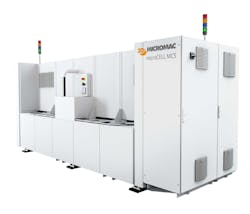Laser cutting system has use in half and shingled solar cell manufacturing
3D-Micromac AG (Chemnitz, Germany) has introduced its microCELL MCS advanced laser cutting system for half and shingled solar cells. The system meets photovoltaics (PV) market demands for boosting module power output and service life by minimizing power losses and providing for an exceptionally high mechanical strength of cut cells. It enables high throughputs for cutting cell sizes up to M12/G12 into half-cells or shingled cells.
PV module manufacturer Heckert Solar GmbH has purchased two microCELL MCS systems for its plants in Thuringia (LWD Solar GmbH) and Chemnitz.
The microCELL MCS system employs 3D-Micromac’s thermal laser separation (TLS) process, which is ablation-free, for cell separation. The separated cells have up to 30% higher mechanical strength compared to ablative laser processes and enable a lower power degradation over the solar module’s life cycle. TLS has also been shown to achieve a module power gain of at least 2 W.
In standard configuration, the laser system cuts half-cells. Depending on the number of laser sources, the system is able to cut up to sixth-cut cells without decreasing the throughput. It also offers productivity of more than 6000 wafers per hour, and can be integrated with additional laser modules to increase the number of cell cuts. The system works with solar cells with temperature-sensitive coatings or depositions such as heterojunction technology (HJT) cells.
